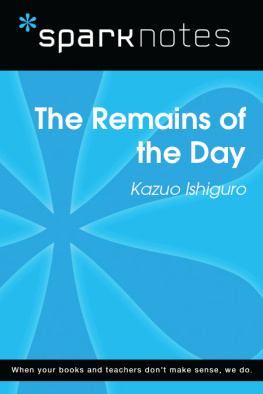A Raisin in the Sun
Lorraine Hansberry
2003, 2007 by Spark Publishing
This Spark Publishing edition 2014 by SparkNotes LLC, an Affiliate of Barnes & Noble
All rights reserved. No part of this publication may be reproduced, stored in a retrieval system, or transmitted in any form or by any means (including electronic, mechanical, photocopying, recording, or otherwise) without prior written permission from the publisher.
Sparknotes is a registered trademark of SparkNotes LLC
Spark Publishing
A Division of Barnes & Noble
120 Fifth Avenue
New York, NY 10011
www.sparknotes.com /
ISBN-13: 978-1-4114-7724-7
Please submit changes or report errors to www.sparknotes.com/.
10 9 8 7 6 5 4 3 2 1
Context
L orraine Hansberry was born in Chicago on May 19, 1930 , the youngest of four children. Her parents were well-educated, successful black citizens who publicly fought discrimination against black people. When Hansberry was a child, she and her family lived in a black neighborhood on Chicagos South Side. During this era, segregationthe enforced separation of whites and blackswas still legal and widespread throughout the South. Northern states, including Hansberrys own Illinois, had no official policy of segregation, but they were generally self-segregated along racial and economic lines. Chicago was a striking example of a city carved into strictly divided black and white neighborhoods. Hansberrys family became one of the first to move into a white neighborhood, but Hansberry still attended a segregated public school for blacks. When neighbors struck at them with threats of violence and legal action, the Hansberrys defended themselves. Hansberrys father successfully brought his case all the way to the Supreme Court.
Hansberry wrote that she always felt the inclination to record her experiences. At times, her writingincluding A Raisin in the Sunis recognizably autobiographical. She was one of the first playwrights to create realistic portraits of African-American life. When A Raisin in the Sun opened in March 1959 , it met with great praise from white and black audience members alike. Arguably the first play to portray black characters, themes, and conflicts in a natural and realistic manner, A Raisin in the Sun received the New York Drama Critics Circle Award for Best Play of the Year. Hansberry was the youngest playwright, the fifth woman, and the only black writer at that point to win the award. She used her new fame to help bring attention to the American civil rights movement as well as African struggles for independence from colonialism. Her promising career was cut short when she died from cancer in 1965 , at the age of thirty-four.
A Raisin in the Sun can be considered a turning point in American art because it addresses so many issues important during the 1950 s in the United States. The 1950 s are widely mocked in modern times as an age of complacency and conformism, symbolized by the growth of suburbs and commercial culture that began in that decade. Such a view, however, is superficial at best. Beneath the economic prosperity that characterized America in the years following World War II roiled growing domestic and racial tension. The stereotype of 1950 s America as a land of happy housewives and blacks content with their inferior status resulted in an upswell of social resentment that would finally find public voice in the civil rights and feminist movements of the 1960 s. A Raisin in the Sun, first performed as the conservative 1950 s slid into the radical sixties, explores both of these vital issues.
A Raisin in the Sun was a revolutionary work for its time. Hansberry creates in the Younger family one of the first honest depictions of a black family on an American stage, in an age when predominantly black audiences simply did not exist. Before this play, African-American roles, usually small and comedic, largely employed ethnic stereotypes. Hansberry, however, shows an entire black family in a realistic light, one that is unflattering and far from comedic. She uses black vernacular throughout the play and broaches important issues and conflicts, such as poverty, discrimination, and the construction of African-American racial identity.
A Raisin in the Sun explores not only the tension between white and black society but also the strain within the black community over how to react to an oppressive white community. Hansberrys drama asks difficult questions about assimilation and identity. Through the character of Joseph Asagai, Hansberry reveals a trend toward celebrating African heritage. As he calls for a native revolt in his homeland, she seems to predict the anticolonial struggles in African countries of the upcoming decades, as well as the inevitability and necessity of integration.
Hansberry also addressed feminist questions ahead of their time in A Raisin in the Sun. Through the character of Beneatha, Hansberry proposes that marriage is not necessary for women and that women can and should have ambitious career goals. She even approaches an abortion debate, allowing the topic of abortion to enter the action in an era when abortion was illegal. Of course, one of her most radical statements was simply the writing and production of the playno small feat given her status as a young, black woman in the 1950 s.
All of this idealism about race and gender relations boils down to a larger, timeless pointthat dreams are crucial. In fact, Hansberrys play focuses primarily on the dreams driving and motivating its main characters. These dreams function in positive ways, by lifting their minds from their hard work and tough lifestyle, and in negative ways, by creating in them even more dissatisfaction with their present situations. For the most part, however, the negative dreams come from placing emphasis on materialistic goals rather than on familial pride and happiness. Hansberry seems to argue that as long as people attempt to do their best for their families, they can lift each other up. A Raisin in the Sun remains important as a cultural document of a crucial period in American history as well as for the continued debate over racial and gender issues that it has helped spark.
A Note on the Title
Lorraine Hansberry took the title of A Raisin in the Sun from a line in Langston Hughess famous 1951 poem Harlem: A Dream Deferred. Hughes was a prominent black poet during the 1920 s Harlem Renaissance in New York City, during which black artists of all kindsmusicians, poets, writersgave innovative voices to their personal and cultural experiences. The Harlem Renaissance was a time of immense promise and hopefulness for black artists, as their efforts were noticed and applauded across the United States. In fact, the 1920 s are known to history as the Jazz Age, since that musical form, created by a vanguard of black musicians, gained immense national popularity during the period and seemed to embody the exuberance and excitement of the decade. The Harlem Renaissance and the positive national response to the art it produced seemed to herald the possibility of a new age of acceptance for blacks in America.
Langston Hughes was one of the brightest lights of the Harlem Renaissance, and his poems and essays celebrate black culture, creativity, and strength. However, Hughes wrote Harlem in 1951 , twenty years after the Great Depression crushed the Harlem Renaissance and devastated black communities more terribly than any other group in the United States. In addition, the postWorld War II years of the 1950 s were characterized by white flight, in which whites fled the cities in favor of the rapidly growing suburbs. Blacks were often left behind in deteriorating cities, and were unwelcome in the suburbs. In a time of renewed prosperity, blacks were for the most part left behind.



















